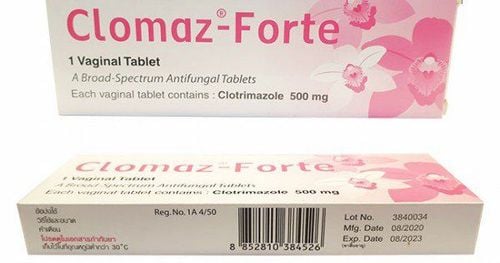This is an automatically translated article.
Gynoflor is a vaginal tablet that works to restore lactobacillus bacteria in the vagina, and at the same time, it helps to improve atrophic vaginitis, bacterial vaginal discharge and prevent the recurrence of vaginal infections. religion. Before and during the use of Gynoflor, you need to consult your doctor carefully and use the medicine exactly as prescribed to achieve optimal results.
1. What is Gynoflor?
Gynoflor is a vaginal tablet, used mainly for the treatment of restoring the number of Lactobacillus acidophilus bacteria in the vagina, atrophic vaginitis due to lack of estrogen hormone, vaginal discharge by bacteria / Candida and prevention of recurrent bacterial vaginosis in women. Gynoflor suppositories are manufactured by Haupt Pharma, belonging to the group of gynecological drugs, with a box of 1 blister x 6 tablets or a box of 2 blisters x 6 tablets, containing the following main active ingredients:
About 100 million bacteria Live Lactobacillus acidophilus Active ingredient Estriol 0.03mg. Active ingredients are enough for one tablet: Microcrystalline cellulose, Anhydrous disodium phosphate, Lactose monohydrate, Magnesium stearate and sodium starch glycolate.
2. What are the effects of Gynoflor?
2.1. Indications for use of the drug Gynoflor Gynoflor suppositories are usually prescribed by doctors for the following specific cases:
Restoration of the amount of Lactobacillus bacteria in the vagina after a course of systemic or local treatment with chemotherapy and certain anti-infective drugs. Treatment of atrophic vaginitis due to estrogen deficiency in menopausal/postmenopausal women, or who are receiving treatment in combination with systemic hormone replacement therapy (HRT). In case of abnormal vaginal discharge with no specific cause, or vaginal disease caused by bacteria, mild to moderate vaginal candidiasis (no need to apply therapy). Antimicrobial). Gynoflor is additionally indicated for the prevention of conditions with a high risk of recurrent bacterial vaginosis. 2.2. In terms of the main ingredient Lactobacillus acidophilus in Gynoflor, this is a type of beneficial bacteria that plays an important role in keeping women's vagina healthy. These microorganisms are all non-pathogenic bacteria, they often stimulate the fermentation of glycogen stored in the vaginal epithelium to convert it to lactic acid. When creating an acidic environment with a pH of 3.8 - 4.5, it can prevent the occupancy and growth of pathogenic bacteria, and at the same time help create favorable conditions for the proliferation of beneficial bacteria lactobacillus. . Not only that, the lactobacillus acidophilus also helps stimulate the production of hydrogen peroxide and bacteriocin - substances that inhibit the proliferation and growth of pathogenic microorganisms in the female vagina.
The other main active ingredient in Gynoflor suppositories is estriol – this is a hormone that has similar effects to the female hormone estrogen. In general, this active ingredient has a specific effect on the vagina, but does not affect the uterine lining. In Gynoflor, the estriol component plays a role in helping to ensure the proliferation and development of the vaginal epithelium, thereby creating a natural protective barrier as well as storing the necessary glycogen for the lactobacilluss. Exogenous estriol when used in low doses also improves the growth and healthy development of the epithelium in the vagina. This helps to provide optimal conditions for the restoration of the lactobacillus population in the female vagina.
The treatment concept of Gynoflor is based on the ability to restore the amount of beneficial vaginal bacteria thanks to exogenous lactobacillus, the effect of improving the proliferation and maturation of the vaginal epithelium of exogenous estriol. This leads to the re-establishment of the physiological balance for the bacteria living in the vaginal environment as well as the vaginal epithelium.
According to research, the active ingredient estriol and beneficial bacteria lactobacillus acidophilus in Gynoflor suppositories can best promote their effects when treated locally in a woman's vagina. Since lactobacillus is a natural probiotic in the body, it is completely absorbed. As for the active ingredient estriol, it will be in a biologically inactive form when excreted in the urine.
3. Dosage and how to use Gynoflor
3.1. Dosage of the drug Gynoflor The dosage of Gynoflor vaginal suppositories will be determined based on the main treatment goal and the patient's condition, specifically:
The usual dose for the treatment of restoring microorganisms in the vagina. , Unexplained vaginal discharge, mild - moderate vaginal infections: Put 1-2 Gynoflor tablets / day, continuously treat within 6-12 days. Usual dose for treatment of atrophic vaginitis: Put 1 Gynoflor tablet / time / day, treat within 6-12 days, then use a maintenance dose of 1 tablet / time, use about 1-2 days / week. 3.2. How to use Gynoflor medicine Gynoflor medicine can work best when placed deep in the vagina and used at night before going to bed. Here are the notes for the correct use of Gynoflor suppositories:
When placing the medicine, you should do it in a lying position, so that the shins are slightly flexed. If the vagina is dry, you can wet the pill before inserting it into your vagina. You can use a pad or sanitary napkin when placing Gynoflor . Because Gynoflor contains excipients that are not completely soluble, you may notice the amount of drug excreted on the surface of the underwear. However, this is completely normal and does not affect the effectiveness of Gynoflor. In addition, during the course of treatment, you should not use the suppository while you are menstruating, instead wait for the period to pass before taking it again. In addition, patients should also avoid using warm baths or deep vaginal douches during treatment with Gynoflor.
4. What to do in case of overdose or missed dose of Gynoflor?
In case of missed dose of Gynoflor
Although missing a dose of Gynoflor does not cause any harm, it can affect the effectiveness of the treatment. In order to help completely treat bacterial vaginosis, you should put the medicine regularly according to the frequency and dosage prescribed by your doctor. If you miss a dose, try to order it as soon as you remember. In general, you should keep the interval between 2 Gynoflor applications at least 8 hours.
Gynoflor overdose case
Currently, there have not been any reports of the danger of Gynoflor when overdosed. However, this condition does not increase the effectiveness of the drug, even putting patients at risk of some unwanted side effects. Therefore, patients should only take the drug in accordance with the dose prescribed by the doctor, avoiding arbitrarily increasing the dose for personal treatment purposes.
5. Cases of contraindications to the use of Gynoflor
In general, whether Gynoflor is good depends on the goal of treatment as well as other health conditions that the patient is suffering from. The following are cases in which Gynoflor is not allowed to be used without the approval of a doctor:
People who are allergic or hypersensitive to the active ingredients or to any of the excipients contained in Gynoflor suppositories. Women with estrogen-dependent tumors (malignant changes) in the uterus, breasts, or vagina. Women with suspected or symptomatic endometritis. Women with vaginal bleeding of unknown cause. Adolescents have not yet reached full sexual maturity.
6. Some important notes during treatment with Gynoflor
6.1. Side effects of the drug Gynoflor During the use of Gynoflor suppositories, some unwanted side effects may arise and affect the patient's health. However, the majority of side effects occur at the treatment site, rarely occur systemic side effects. The following are undesirable effects caused by Gynoflor drugs:
Symptoms of itching with mild burning (accounting for 1.6%), may appear immediately after the patient puts the medicine into the vagina. Rarely, drug intolerance reactions, including itching or redness of the treatment site, have been reported. For the case of swallowing the wrong tablet, Gynoflor usually does not record any side effects for the patient. If an allergic reaction occurs to the ingredients of the drug, you need to stop using the drug and immediately inform your doctor about the condition you are experiencing so that proper measures can be taken.
6.2. What precautions should be taken while using Gynoflor? According to experts' recommendations, pregnant women should be cautious when using Gynoflor suppositories, especially in the first 3 months of pregnancy. To prevent possible unfortunate risks, you need to inform your doctor about your pregnancy before making a decision to use the drug.
For lactating women, the use of Gynoflor is within the limits of the doctor's permission and does not affect the quality of milk as well as the health of the newborn. However, like any other medication in general, nursing women should exercise caution and consult with their doctor about the benefits and risks of taking Gynoflor.
6.3. What drugs may interact with Gynoflor? Drug interactions can decrease your ability to work or increase your risk of side effects. Therefore, you need to make a list of all drugs or products you are using to your doctor, including over-the-counter drugs, prescription drugs, herbs or supplements. According to scientific research, Gynoflor may interact with the following drugs as well as the following conditions:
Other anti-infectives (systemic or topical): The lactobacillus acidophilus component in Gynoflor may be sensitizing to some other anti-infective drugs. When combined with these two drugs, the effectiveness of Gynoflor suppositories may be reduced. Alcohol, tobacco or food: You need to talk to your doctor when using Gynoflor with food or stimulants. Health conditions: Tell your doctor about any health problems you have because it may affect the treatment of Gynoflor. 6.4. Storage conditions for Gynoflor medicine Gynoflor tablets should be stored in a refrigerator at a temperature ranging from 2 to 8 degrees Celsius. In addition, patients should also store Gynoflor at room temperature for a period from 1 day. - 2 weeks. If the medicine is left over this time, it can significantly affect the therapeutic effect of Gynoflor.
In case you notice that the suppository shows signs of mold, damage or changes in color, you need to stop using it immediately and notify your doctor for proper treatment.
Follow Vinmec International General Hospital website to get more health, nutrition and beauty information to protect the health of yourself and your loved ones in your family.
Please dial HOTLINE for more information or register for an appointment HERE. Download MyVinmec app to make appointments faster and to manage your bookings easily.













